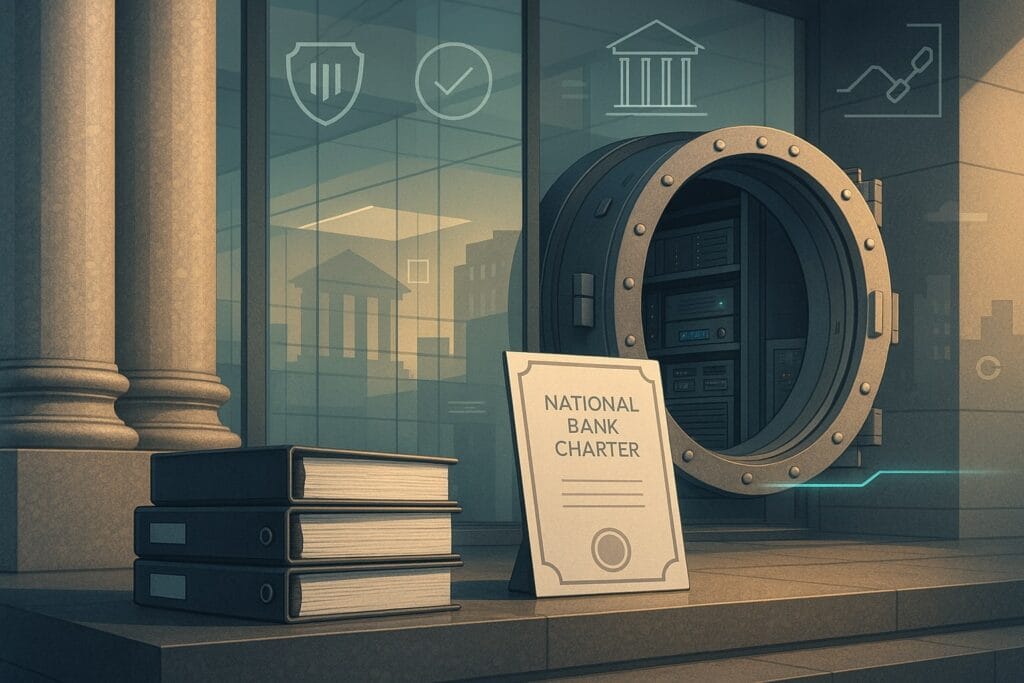Inside the fine print: what the approval implies for compliance, competition and the road to launch
Table of Contents
ToggleKey takeaways
- The Office of the Comptroller of the Currency (OCC) granted preliminary, conditional approval for a new national bank charter for Erebor Bank — a tech- and crypto‑adjacent entrant backed by prominent Silicon Valley investors (Oct 15, 2025).
- The OCC’s letter is not a licence to open doors: Erebor must still obtain Federal Deposit Insurance Corporation (FDIC) deposit insurance and apply for membership with the Federal Reserve System before launch.
- The approval — and the conditions attached — offer a read‑through on how U.S. regulators may supervise banks that touch digital assets: strong risk controls first; activity permissions second.
- Backers and management signal a lending‑plus‑deposits model targeted at technology sectors (AI, digital assets, defence manufacturing), with reports pointing to collateral and risk models that differ from traditional banks.
What happened
On Wednesday, October 15, 2025, the OCC announced it had “conditionally approved” a de novo national bank charter for Erebor Bank. The agency also issued a preliminary conditional approval letter that spells out the next steps before the bank can open to the public. Those steps include applying for stock in a Federal Reserve Bank (i.e., pursuing Federal Reserve membership) and securing FDIC deposit insurance. The OCC also granted certain residency waivers for proposed directors — a routine but notable detail in de novo charters where organisers recruit nationally.
Why it matters
If Erebor ultimately launches under a full national bank charter, it would become a rare example of a technology‑oriented bank entering the system through the front door. In the post‑SVB landscape, most fintechs have avoided the costly charter route, opting instead to rent licenses from sponsor banks or to operate as state‑chartered trust companies. A federal charter, however, confers durable advantages — direct supervision by a prudential regulator, nationwide pre‑emption on key activities and the opportunity to build low‑cost deposit funding — while imposing correspondingly high expectations for governance, liquidity, capital and compliance.

The fine print that jumps out
- Pre‑opening hurdles: The OCC’s preliminary letter makes plain that Erebor cannot begin the “business of banking” until all pre‑opening conditions are satisfied. In practice, that means demonstrating operational readiness across BSA/AML, vendor risk, liquidity management, model governance and customer disclosures — alongside the separate FDIC and Federal Reserve processes.
- Federal Reserve membership: The letter explicitly contemplates Erebor applying for stock in a Federal Reserve Bank. Membership would bring access to the Fed’s supervisory framework and, subject to separate approvals, potential access to payment services. The decision also signals the OCC’s expectation that a tech‑forward bank sits squarely inside the traditional safety‑and‑soundness perimeter.
- Deposit insurance: FDIC insurance is not automatic or perfunctory; it runs on its own statutory tests. De novo applicants must show credible risk management, sufficient capital and a sound business plan. Timelines vary by case and public‑comment cycles.
- Governance and residency: The conditional approval references residency waivers for certain directors. This can help early‑stage banks assemble specialised boards while still meeting oversight and availability expectations.
Who is behind Erebor
Reporting in the financial press identifies Erebor’s backers and organisers as including Palmer Luckey, with investments linked to Peter Thiel and Joe Lonsdale. Coverage also frames the bank’s target customer base as technology sectors — artificial intelligence, digital‑asset companies and defence‑adjacent manufacturers — that have faced uneven access to credit and payments since 2023.
Business model: where the risk lives
Early reports suggest Erebor aims to pair traditional deposit products with specialised lending and treasury services. Some outlets have pointed to potential lending secured by non‑traditional collateral (for example, digital assets or AI‑related hardware). If borne out, that would place a premium on collateral valuation methods, concentration limits, margining and real‑time risk monitoring — areas where regulators have become especially exacting after the last cycle.
How this differs from previous ‘crypto‑friendly’ models
The U.S. playbook to date has split along two paths. Wyoming’s Special Purpose Depository Institutions (SPDIs) sought to operate custody‑led models without deposit insurance, while several fintechs pursued national charters by acquisition or conversion. Erebor’s de novo national charter — if completed — would be different: a full‑service national bank subject to ongoing prudential supervision, not a limited‑purpose institution. For firms seeking durable banking access, that distinction matters more than branding: the supervisory baseline is higher, but so is the strategic flexibility.
Politics and perception
The approval has already drawn mixed reactions — from praise that the OCC is normalising bank‑led digital‑asset activity under strict controls, to concern from some policymakers about speed and potential conflicts. Both things can be true: innovation is better supervised inside the perimeter, and scrutiny of governance, personnel moves and risk appetite should be intense. Either way, the substantive test now shifts from rhetoric to execution: can the organisers build a bank that passes the routine, grinding tests of safety and soundness?
What to watch next (practical markers)
- FDIC docketing: When the FDIC posts Erebor’s deposit insurance application for public comment, note the comment volume and the issues raised (liquidity, business‑plan durability, BSA/AML controls).
- Board and executive hires: Look for appointments with deep de novo, treasury and risk‑model credentials — especially in consumer compliance and operational resilience.
- Vendor map: Which core provider and which payments partners? Third‑party risk management will be decisive for both cost and control.
- Initial product sequencing: Will Erebor start with insured business checking and simple working‑capital lines, or prioritise specialised lending first? The order says a lot about risk appetite and regulator comfort.
- Geography: Residency waivers aside, where the bank builds its first‑line teams (and how it supervises them) will shape the first exam cycle.
Bottom line
Conditional approval is not the finish line; it is permission to try. Yet the OCC’s decision reads as an invitation for banks to engage with digital‑asset clients under mature controls rather than avoiding them altogether. If Erebor executes cleanly through FDIC and Federal Reserve reviews — and then through the unglamorous first two exam cycles — it will not just open a bank. It will reopen a pathway for technology finance that many assumed had closed.












